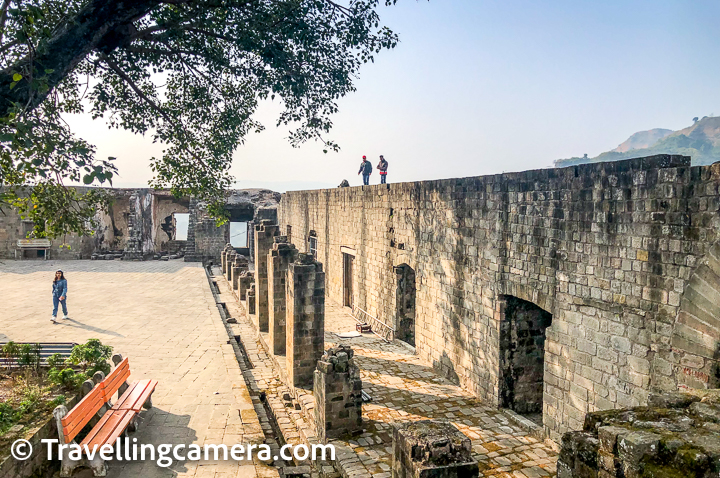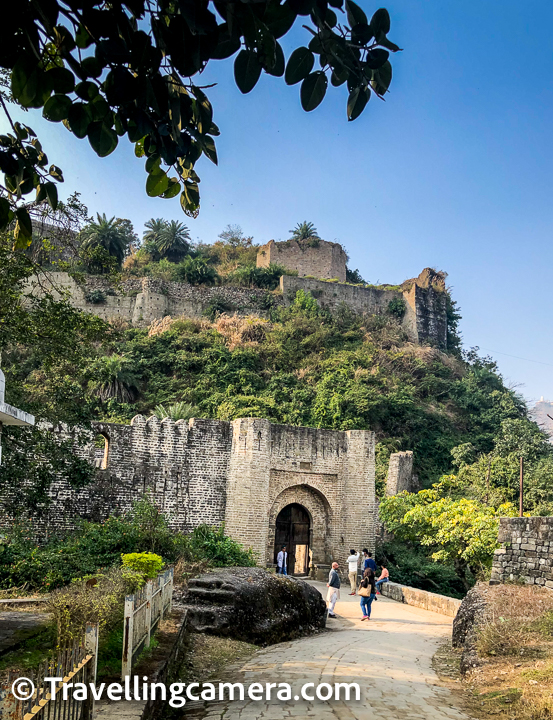The Splendid Kangra Fort of Himachal Pradesh || An Ancient Jewel that Survived Millenniums and is Magnificent even in Ruins
During our recent trip to Dharamshala, Himachal Pradesh, we also planned a visit to Kangra Fort. So one morning, we started from our camp near the Indrunag temple and headed out toward Kangra. The fort is located very close to Kangra town and is visible from quite a distance because it resides at one of the highest points in Kangra.
The ticket can be purchased at the gate or online and is a nominal Rs. 25 for Indian Citizens and visitors from SAARC and BIMSTEC Countries. Remember to carry a government ID for verification.
Related Blogpost - Dhauladhar Nature Park & Zoo in Gopalpur, Kangra, Himachal Pradesh - A great place around snow covered mountains of Palampur-Dharmshala for good time with Kids
The Fort is the largest of its kind in the Himalayas and is the 8th largest in India, as per the Archeological Survey of India. It covers an area of 463 acres. Spanning 4 km on both sides, the fort is guarded by grand, black stone walls.
Related Blogpost - Mixed feelings from our quick visit to tiny zoo in Rewalsar, a Lake Town of Himachal Pradesh
In the main courtyard are three temples dedicated to Ambika Devi, Lakshmi Narayan, and Lord Mahavir. There are 11 gates in the fort, foremost of which is the the Andheri Darwaza, boasting of a height of 15 ft.
Related Blogpost - A relaxing evening around Pong Dam Wetlands with some birds, colourful sunset & snow covered Dhauladhar mountains around us
The fort has endured several plunderers, various forced sieges, many wars, and countless occupants who stayed here in peace or in unrest. But the fort stood the test of time and its walls never shook or crumbled through all the ascension or looting. However, when an earthquake measuring 7-8 on Richter scale struck the region, the fort gave in.
It suffered massive damage and you can find the traces of the devastation till date. The inner chambers and temples and walls, that had stood tall for millennia, now lie in ruins, defeated not by long-drawn human wars, but by one momentary act of nature.
Related Blogpost - Our learnings about rescuing a car stuck in marshy land - A story about how our car got stuck in slippery muddy (clay) wetlands of Pong Dam in Himachal Pradesh
But before that, the fort was constantly changing hands, with conquerors travelling hundreds of miles lured by the deep wells full of gold, silver, and jewels in the fort. The wells were not a legend. These really existed.
These riches were sent by the wealthy devotees of the Brijeshwari Temple as an offering to the large idol inside the temple. The wealth amounted to so much that as per the legends, the Kangra fort had 21 treasure wells – each well being 4 meters deep and about 2 and a half meters in circumference.
Related Blogpost - Indrunag Temple in Dharmshala, Himachal Pradesh - A mountain peak with spectacular views of Mcleodganj, Dharmpur and snow covered Dhauladhar Himalayan Ranges
Of these wells, the Sultan of Ghazni plundered eight wells, and the British took five more wells. As per the locals, the fort has eight more wells, full of treasure. But don't go looking for them. I am pretty sure it is illegal to excavate.
However, owing to these treasure wells, plunderers and other rulers eyed Kangra Fort all through the medieval ages. The earliest documented attack dates to 470 AD by the Raja of Kashmir, Shreshtha Sen. The Katochs successfully defended their fort against this attack.
Related Blogpost - Ellora of Himachal Pradesh maintained by Archaeological Survey of India - Masroor Rockcut Temple || A Monolithic Temple in Kangra Region of Himalayan State, India
One of the most famous attack on the fort was that by Mahmud of Ghazni in 1009CE during which much of the wealth (as mentioned 8 out of 21 treasure wells) was plundered. This siege finds a mention in historian Al-Utbi's Tarikh-i-Yamini, dated 1021AD. Quoting his words here about the loot, "The amount was so huge that the backs of camels could not carry it, nor vessels contain it, nor writer’s hands record it, nor imagination of an arithmetician conceive it.”
Another well talked about siege was the one by Delhi Sultan Muhammad-Bin-Tughlaq in 1337 AD, The Sultan was however not able to hold it for long. His son Feroz Shah Tughlaq again attacked the fort in in 1351 AD. At that time, Katoch ruler Rajanaka Roop Chand was at the helm. The siege lasted for months without any conclusion.
Related Blogpost - Beautiful Church in Mcleodganj, Himachal Pradesh || St. John Church near Dharmshala Town
Kangra fort remained much sought after in the 16th century as well. In the year 1540, a general of Sher Shah Suri conquered the Kangra fort. However, in order to let peace prevail, a treaty was signed. The next dynasty to get interested in Kangra fort was the Mughals.
Related Blogpost - World's Highest Altitude Cricket Stadium in Dharmshala - Unimaginable location surrounded by snow covered Himalayan peaks & stunning tea-estates of Himachal Pradesh
The lure must really have been strong because Emperor Akbar allegedly unsuccessfully attempted to annex the fort 52 times. While he couldn't succeed, his son Jahangir occupied the fortress after a siege lasting 14 months. This was in the year 1620. At the end of this struggle, the Katoch king Raja Hari Chand was killed. The Kangra kingdom remained a part of the Mughal Empire for almost one and a half centuries.
Raja Sansar Chand Katoch became the ruler of Kangra in the year 1775. He joined hands with the Sikh ruler Jai Singh Kanhaiya of Kanhaiya Misl to recapture the Kangra fort, in exchange for some territories in the plains. Sansar Chand was ambitious and despite his comparatively smaller stature when he ascended the throne, he went on to be known as “Chhatrapati Naresh” and “Pahari Badshah”.
His reign is known as the golden era of the Katoch Dynasty and his contributions weren't just limited to reclaiming lost territory and expanding his kingdom, but also can be seen in art and culture of the Kangra region.
Sansar Chand went on to quickly expand his territory by conquering the kingdoms of Chamba, Mandi, Suket and Nahan, keeping the captured Kings in captivity. This led him to be hugely unpopular in the region. However, when he turned his attention to Punjab, his plans were successfully thwarted by Maharaja Ranjit Singh of Lahore.
In 1805 Sansar Chand started eyeing the kingdom of Bilaspur, prompting the Raja of Bilaspur to seek help from the powerful Gurkhas, who had already started capturing territories in the region. This led of a large army of Gurkhas to cross the Sutlej river and capture fort after fort, until they had the control of Pathiyar (Palampur) Fort.
With Gurkhas just a breath away from Kangra, Sansar Chand sought assistance from Maharaja Ranjit Singh of Lahore, who he had unsuccessfully tried to dethrone earlier. This led to the Sikh Gurkha war of 1809 and the Gurkhas were successfully repelled as a result of this. A treaty was signed after the war, as a result of which Maharaja Ranjit Singh took possession of Kangra fort on Aug 24, 1809, and the rest of Kangra remained with Sansar Chand.
After the Anglo-Sikh war of 1846, the fort came under British control, who looted 5 more treasure wells till 1905 when the earthquake forced them out. And thus the fort again came back to the Katoch Kings. As of now, the fort is managed by the Archeological Survey of India.
Now that we are done with the history lesson on Kangra Fort, let's also talk a bit about the mentions this ancient fort and the Katoch Dynasty find in our ancient texts as far back as Ramayan and Mahabharat. And the History of the Katoch Clan and the Kangra Fort are inseparable from each other. The clan even finds a mention in our mythology in the Raktbeej Vadh mentioned in Markandeya Purana.
As per the legend, when Goddess Ambika was fighting the demon Raktbeej, who resurrected with every drop of his blood that fell on the earth, a drop of her sweat fell on the ground as she was wiping her sweat. from this drop of sweat arose the first Katoch known as Bhumi Chand.
With Bhumi Chand's assistance, the Goddess was successful in defeating the demon. Happy with his help, Goddess Ambika rewarded Bhumi Chand Katoch with the kingdom then known as Trigarta, which denotes the land of the three rivers, Ravi, Beas, and Sutlej. Kangra is a part of this region.
Folklores credit Katoch King Rajanaka Susharma Chand for building the Kangra Fort. After the battle of Mahabharata, once the Kauravs lost to Pandavs, Susharma Chand, who was an ally of the Kauravs, chose to retreat to the Kangra Region instead of heading back to his Kingdom in Multan. He is then said of have built the Kangra Fort around 3,500 years ago.
Apparently the first mention of Kangra is found in the Greek Astronomer and Geographer Claudius Ptolemy's text, in which he mentions the famous King Porus who fought with Alexander the Great and even though he lost to the conqueror, managed to impress him. This King Porus is, as per some historians, the Katoch King Parmanand Chand.
Even though the fort lies in ruins today, you can still find traces of the past splendor in the tall walls, the carvings and the various temples and courtyards. Even today, it is impossible to understand the Fort without understanding its history. And history's tangible footprints can actually be found here in form of the various gates that the conquerors built here, such as the Jahangiri Darwaza (attributed to Mughal Emperor Jahangir), the Ahani and Amiri Darwaza, (attributed to the first Mughal Governor of Kangra Nawab Saif Ali (Alif) Khan), and the Ranjit Singh Darwaza, (attributed to Maharaja Ranjit Singh).
If you happen to visit Kangra or Dharamshala, a visit to the Kangra Fort is definitely recommended. It is a gorgeous ancient building despite being ravaged by plunderers and nature across centuries.
If you liked this post and found it helpful, I would request you to follow these things when traveling -
1. Manage your waste well and don’t litter Use dustbins.
2. Tell us if you went to a place and found it hard to locate a dustbin.
3. Avoid bottle waters in hills. Usually you get clean water in hills and water bottles create lot of mess in our ecosystem.
4. Say big no to plastic and avoid those unhealthy snacks packed in plastic bags. Rather buy fruits.
5. Don't play loud blaring music in forests of jungle camps. You are a guest in that ecosystem and disturbing the locals (humans and animals) is not polite.





























.jpg)